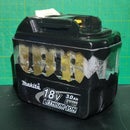Introduction: Easy Rustic Prop Rack
Most people who have ventured into the art of prop and costume making will know just how much space the hobby can take up. The props that I haven't yet managed to tactically distribute around the house are mostly piled up at the side of my room. Inspired by examples of pinboard-style tool pin boards used by people who have replicated entire arsenals from films and games, I looked into the cheapest and most convenient ways to wall mount my props and other loose items.
Step 1: Sourcing the Wood
Prefabricated pin boards can be expensive to buy when covering part of, or an entire wall. My first concept for wall mounting the props would be to take a sheet of 6-10mm thick plywood trim it to the required dimensions of 115cm x 234cm, then manually mark and drill out all the holes. Unfortunately, my car would still require me to cut this down into at least 3 sections to fit it in, and while delivery was possible, the cost or minimum order quantity made it unfeasible.
To keep the costs down by transporting them myself, I re-imagined it as a wooden slat style mounting rack, which opened the possibilities to using old decking, floorboards and even dismantled shipping pallets.
These can even be found for free, if not very low prices on sites like Facebook marketplace or Gumtree, as long as they are structurally sound and not riddled with woodworm! With the help of a jigsaw, I was able to get the 3 pallets I needed into my car, although I could have fitted in more if I'd had the time to take them apart prior.
Step 2: Preparing the Wood
Allowing a 1cm gap between each slat of wood, I made sure I had enough to cover the wall from skirting board to ceiling, and cut down the few 120cm lengths to match the wall's 115cm. Most of the slats were only 100cm, but this turned out to my advantage, as it added more variety. Even the slats that I'd cut in half to help fit the pallets in my car looked great when added to the array.
To round off all the edges, and smooth any rough slats I used a sanding disk on my angle grinder. The whole process only took around 15 minutes.
In order to create a gap behind the slats, I measured out 4 lengths of 3x1 timber to match the height of the wall, then cut each into 3 equal pieces, resulting in 12 lengths of 78cm. These would not only create a gap between the slats and wall to fit hooks in, but also allowed me to pre-assemble the rack outside without the issue of maneuvering the whole thing through the house.
Step 3: Painting + Assembly
By using a water based wood stain or paint mixture diluted with water in several different concentrations you can create enough different shades to make the wood look much more randomly sourced, especially if the wood pieces already vary in colour somewhat.
One of the pallets I used had been previously stained green, which gave an interesting aged look to it after sanding away most of the surface and staining it.
To hide the rear 3x1 braces, I painted them the same shade of Magnolia as the wall, then screwed between 6 and 7 slats of wood onto each set of 4 braces using 30-40mm wood screws depending on their thickness. After transferring the three completed panels to the wall, I removed a screw from each corner and two in the middle (6 in total) then screwed in a slightly longer screw to each empty hole to mark its location on the wall. With the locations marked and the whole wall checked over for pipes and buried cables, I used masonry drill bits and rawl plugs to create anchor points in the wall for the panels, then replaced the panel in its original position using 80mm screws where the originals were removed.
There was a slight issue with one panel being warped, which could have been resolved by attaching the braces to the wall before adding the slats, but this method allowed me to view the whole array on the floor outside first, and also meant no slats would have to be removed if the panels had to be removed.
Step 4: Hanging the Props
The quickest way to attach a wide assortment of object shapes and sizes was to bend custom hooks from steel armature wire. 3-4mm diameter galvanised steel wire worked perfectly, and is available at most garden centres. Some brands are more easily bent than others, which makes forming the hook shape easier, but may cause heavier props to sag.
Using 2 or 3 metal hooks per prop, most of the props that I'd previously had to lean up against the corners of the room are now more visible and take up far less floor space.
For a project that can be completed well within a weekend, this was a great way to liven up a wall!

Participated in the
Furniture Contest 2018













